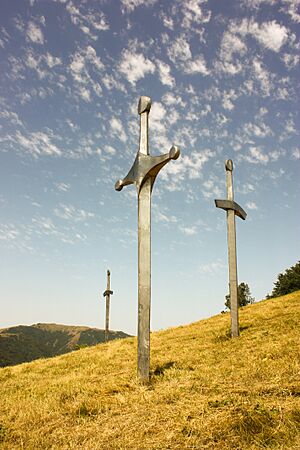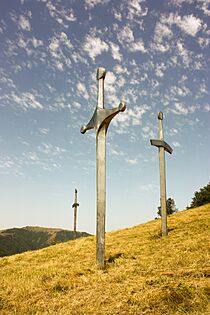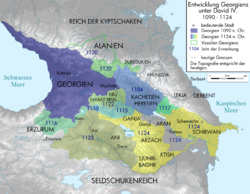Battle of Didgori facts for kids
Quick facts for kids Battle of Didgori |
|||||||
|---|---|---|---|---|---|---|---|
| Part of the Georgian–Seljuk wars | |||||||
 Didgori monument |
|||||||
|
|||||||
| Belligerents | |||||||
|
|
||||||
| Commanders and leaders | |||||||
| Ilghazi (WIA) Tughril bin Muhammad Dubays II |
David IV Prince Demetrius |
||||||
| Strength | |||||||
|
Modern estimates: Medieval Christian sources: Medieval Arab sources 30,000 |
Total: 55,600 (Georgian sources)
|
||||||
The Battle of Didgori was a very important fight between the armies of the Kingdom of Georgia and the Seljuk Empire. It happened on August 12, 1121, in the narrow Didgori Valley, about 40 kilometers west of Tbilisi.
A huge Muslim army, led by a commander named Ilghazi, was defeated by the Georgian army. This happened because the Georgian King David IV used very smart military plans. The battle at Didgori was the most important event in the long Georgian–Seljuk wars.
This victory allowed the Georgians to take back Tbilisi in 1122. Soon after, King David moved the capital of Georgia from Kutaisi to Tbilisi. The win at Didgori started a "Golden Age" for Georgia. It is remembered in old Georgian writings as a "miraculous victory." Even today, Georgians celebrate this event every year on August 12, during a festival called Didgoroba.
Contents
Who Fought at Didgori?
The Muslim Army
Old writings from both Georgia and Islamic countries say that a large Muslim army was sent to Georgia. This army was led by Ilghazi, a famous military leader. He had recently won a big battle against the Crusaders.
Historians believe the Muslim army was much larger than the Georgian army. Some old sources say there were hundreds of thousands of soldiers. Modern historians think the number was closer to 100,000 to 250,000. Even the lowest estimates show the Muslim army was much bigger than the Georgian forces.
Ilghazi's army entered Georgia in July 1121. They camped near Mount Didgori and Manglisi, about a day's march from Tbilisi. Ilghazi likely planned to use many archers and light cavalry to attack first.
The Georgian Army
The Georgian army was much smaller, with about 56,000 soldiers. But they had a good plan and knew the land well. King David IV had recently made his army stronger. He created a special royal guard called the 'mona-spa'.
The Georgian army included:
- 40,000 Georgians (including 5,000 'mona-spa' elite warriors)
- 15,000 Kipchaks (a group of skilled horsemen)
- 500 Alans (mercenaries)
- 100 to 500 Franks (Crusader knights)
- Allies from Armenia and Shirvan
The 'mona-spa' were well-trained and heavily armored horsemen. They used lances and bows. They were used as shock cavalry, meaning they would charge hard into enemy lines. The Crusaders, Kipchak cavalry, and some foot soldiers were in the middle of the Georgian army. The rest of the army was split into two main groups, hidden from the Seljuks.
King David IV led the left side of his army, and his son, Prince Demetrius, led the right side.
King David's Speech
Before the battle, King David gave an inspiring speech to his soldiers. A French historian, Walter the Chancellor, wrote down his words:
“Soldiers of Christ! If we fight bravely for our Faith, we will defeat not only the devil’s servants, but the devil himself. We will gain the greatest weapon of spiritual warfare when we make a covenant with the Almighty God and vow that we would rather die for His love than escape from the enemy. And if any one of us should wish to retreat, let us take branches and block the entrance to the gorge to prevent this. When the enemy approaches, let us attack fiercely!”
The Kipchaks
The Kipchaks were a group of skilled horsemen. Georgian leaders saw them as good allies against the Seljuks. Around 1109, about 40,000 Kipchaks, led by Otrok Khan, came to Georgia. They became Christians and joined King David IV's army.
This alliance was helped by King David's marriage to Otrok Khan's daughter, Gurandukht. The Kipchaks were given land and supplies. In return, each Kipchak family provided one soldier. This helped King David build a strong standing army.
The Franks
Frankish soldiers also fought in the Battle of Didgori. An Armenian historian mentioned 100 Franks, while Walter the Chancellor said there were 200. These Franks were likely Crusader knights.
It's not clear if they were sent by other Christian rulers or if they were mercenaries (soldiers who fight for pay). However, since both the Franks and Georgians were fighting against the Muslims, they were likely allies. They probably traveled to Georgia through Constantinople, as the land between Antioch and Georgia was controlled by the Seljuks.
The Battle of Didgori
King David knew he had to stop Ilghazi's army before they could join forces with Muslims in Tbilisi. He planned a surprise attack in a hilly, wooded area near the Didgori Mountain range.
On August 11, 1121, King David led his army from Mtskheta. He split his troops into two parts. He led one group himself. The other, smaller group was led by his son Demetrius. This group was hidden behind hills, ready to attack from the side when given a signal.
A Clever Trick
According to an Arab writer, Ibn al-Athir, King David sent a small group of Kipchak soldiers to pretend they were deserting (leaving) the Georgian army. The Muslim leaders thought these Kipchaks were coming to surrender. But when they got close, the Kipchaks attacked with arrows, killing several Muslim commanders.
While this was happening, King David ordered his Crusader knights to attack the front of the Muslim army. This caused a lot of confusion and panic among the Muslims. The Georgian army then quickly moved in from the sides, surrounding the enemy.
Ilghazi and his son-in-law were badly hurt and had to leave the battlefield. With their leaders gone, the Muslim army became even more disorganized.
King David personally led the Georgian right side, charging his heavy cavalry into the confused Muslim left side. At the same time, Demetrius led the left side of the Georgian army, attacking the Muslim right side. When the Georgian foot soldiers joined the fight, the Seljuk troops panicked and ran away.
The Georgians chased them for three days, defeating them completely. The Kipchaks also joined the chase, making sure no enemy soldiers could regroup. The battle was over in about three hours. The Seljuk army suffered huge losses, with many killed, injured, or captured.
Another idea about the battle is that King David used the hilly land to hide his troops. He might have tricked the Seljuk cavalry into a narrow pass where they couldn't move easily. Once trapped, they were attacked by Georgian soldiers with spears, pikes, and bows. The rest of the Muslim army had to climb hills to fight, while being attacked from the sides by heavy cavalry. This broke their will to fight, and they soon ran away.
What Happened After Didgori?
The victory at Didgori was huge. So many Seljuk soldiers ran away that the Georgian cavalry kept capturing prisoners for days. This win allowed Georgia to free itself from Muslim control. Georgia even started to take over lands that belonged to the Seljuk Empire, which was now very weak.
The captured Seljuk soldiers helped King David rebuild his kingdom. In the year after the battle, David laid siege to and captured Tbilisi. This city then became the new capital of Georgia.
Some old writings say King David took revenge on the Muslims in Tbilisi. However, an Arab historian named al-'Ayni said that while the city was looted, King David eventually showed kindness. He respected the feelings of Muslims. King David was a well-educated man who believed in religious tolerance. He removed special taxes for Muslims and Jews and protected Muslim scholars.
Ilghazi, the Muslim commander, was wounded and returned to Mardin in a very bad state. The Battle of Didgori also helped the Crusader states in the Middle East. They had been under pressure from Ilghazi's armies, so his defeat was good news for them.
The victory at Didgori became a legendary event for future Georgian generations. A writer from that time wondered how the stories of Homer or Josephus could compare to the "wonders" God gave them that day. The battle is known in Georgia as a "miraculous victory." It showed that Georgia was becoming a strong military power in the 11th and 12th centuries. It also helped Georgia become a leading cultural and political force in the eastern part of Asia Minor.
Images for kids




